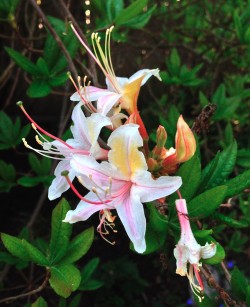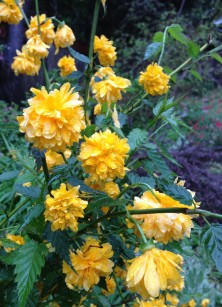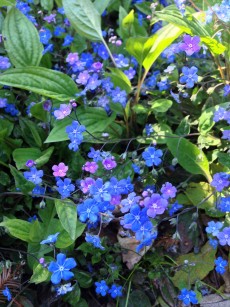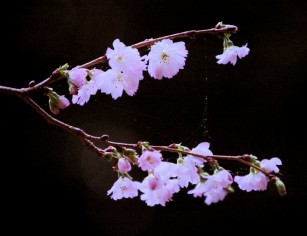 Between holidays and storms I?m spending more time looking out the windows at the garden than I am actually outside in it. We have been fortunate to have received so much rain. We welcome it. We embrace it knowing that the trees are getting a deep soak and the aquifer rejoices. I?m impressed and amazed how many flowering plants are blooming despite being pounded by 33? of rain up here in Bonny Doon. These plants are my heroes and you might just consider including them in your garden too.
Between holidays and storms I?m spending more time looking out the windows at the garden than I am actually outside in it. We have been fortunate to have received so much rain. We welcome it. We embrace it knowing that the trees are getting a deep soak and the aquifer rejoices. I?m impressed and amazed how many flowering plants are blooming despite being pounded by 33? of rain up here in Bonny Doon. These plants are my heroes and you might just consider including them in your garden too.
One of my favorite small ornamental trees that blooms several times in my garden during the year is the Autumnalis flowering cherry. I am not exaggerating when I say it blooms in the spring, a little during the summer, again in the early fall and now in December. I?m not sure how it got the name Autumnalis ?cause it sure can?t read a calendar. I was afraid I would loose the December show with so much pounding rain but the pale pink blossoms have mostly come through just fine and and chickadees who land in it before going to the feeder remind me that spring will be here before I know it.
Another tough plant that can take weather extremes is the Lily-of-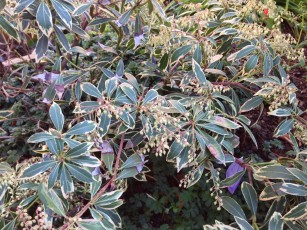 the-Valley shrub (Pieris japonica). There are many varieties of this early winter bloomer. Some have pure white flowers, other sport various shades of pink or dark rose. Mine is the smaller variegated foliage model with dainty, drooping clusters of pure white flowers in early spring. Right now it is covered with flower buds so dense that you?d think it was already blooming. The new growth in the spring has a beautiful pink tint. This shrub will hold up to the wildest weather. Another plus for the Lily-of-the-Valley shrub is that is useful for fire scaping in the landscape and it isn?t on the menu for deer either.
the-Valley shrub (Pieris japonica). There are many varieties of this early winter bloomer. Some have pure white flowers, other sport various shades of pink or dark rose. Mine is the smaller variegated foliage model with dainty, drooping clusters of pure white flowers in early spring. Right now it is covered with flower buds so dense that you?d think it was already blooming. The new growth in the spring has a beautiful pink tint. This shrub will hold up to the wildest weather. Another plus for the Lily-of-the-Valley shrub is that is useful for fire scaping in the landscape and it isn?t on the menu for deer either.
 Camellia flowers, thick, tough and full of color, easily sail through winter weather. Camellias bloom for a long time and with so many types you can have one blooming from October all the way through May. This showy evergreen shrub is drought tolerant once established. Yes, with some mulch and a deep soak every so often they require much less irrigation than you?d think. There are fragrant varieties, such as Pink Yuletide, a sport of the popular red Yuletide.
Camellia flowers, thick, tough and full of color, easily sail through winter weather. Camellias bloom for a long time and with so many types you can have one blooming from October all the way through May. This showy evergreen shrub is drought tolerant once established. Yes, with some mulch and a deep soak every so often they require much less irrigation than you?d think. There are fragrant varieties, such as Pink Yuletide, a sport of the popular red Yuletide.
Camellias are easy to grow in containers. Even if you only have a small space, a variety like Fairy Blush only reaches 4-5 ft and has a delicate fragrance also. Like other types, camellias make wonderful cut flowers. With short stems they work best floated in a low bowl or container. Group them together for a beautiful display of color inside your house.
A favorite of birds and indoor floral arrangers is the evergreen 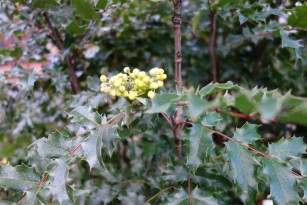 mahonia. They are already blooming with cheery, bright yellow flower clusters that will last for months. When each flower sets a purple berry they look like grape clusters. The edible berries make good jelly, too. There are 70 varieties of mahonia including our own native Oregon Grape which grows in the understory of Douglas fir forests. Mahonia aquifolium is resistant to summer drought, tolerates poor soil and doesn?t create a lot of leaf litter.
mahonia. They are already blooming with cheery, bright yellow flower clusters that will last for months. When each flower sets a purple berry they look like grape clusters. The edible berries make good jelly, too. There are 70 varieties of mahonia including our own native Oregon Grape which grows in the understory of Douglas fir forests. Mahonia aquifolium is resistant to summer drought, tolerates poor soil and doesn?t create a lot of leaf litter.
Other tough winter blooming plants include witch hazel, edgeworthia, michelia and grevillea. Enjoy color in the garden regardless of what Mother Nature brings this winter.

